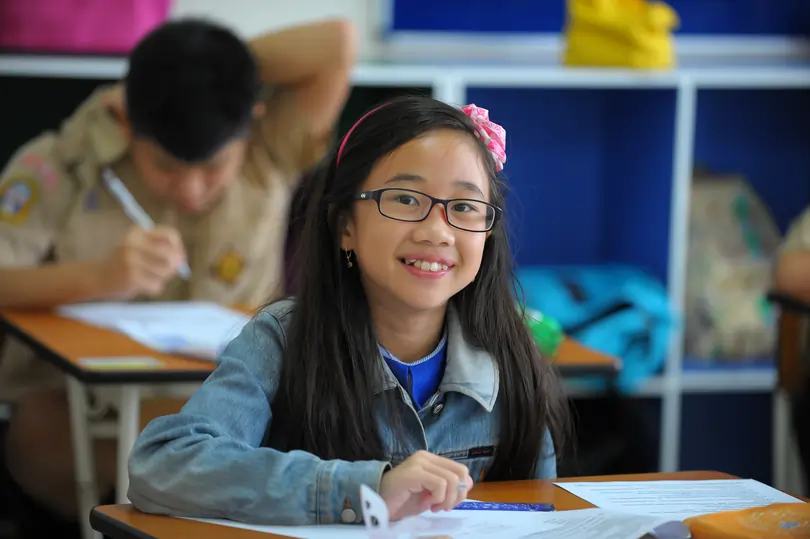Money
In this article, we are going to solve word problems involving addition and subtraction of money.
- Finding the amount of money at first
- Finding the amount of money left
- Finding the cost of item
1. Finding the amount of money at first
Question 1:
A bag cost \($35\). After buying the bag, Melissa had \($15\) left. How much money did she have at first?
Solution:

\($35 + $15 = $50\)
She had \($50\) at first.
Answer:
\($50\)
Question 2:
The cost of a hairdryer is \($44.95\). After buying the hairdryer, Mrs Kumar had \($16.40\) left. How much money did she have at first?
Solution:
To find the amount of money Mrs Kumar had at first, we need to add the cost of the hairdryer and the amount of money left. Remember to align the decimals.
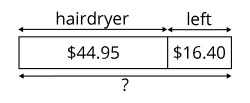
\($44.95 + $16.40 = $61.35\)
She had \($61.35\) at first.
Answer:
\($61.35\)
Question 3:
After buying \(2\) basketballs that cost \($28.80\) each, Michael had \($7.40\) left. How much money did he have at first?
Solution:

\(\begin{align} $28.80+$28.80 &= $57.60\\[2ex] $57.60 + $7.40 &= $65.00 \end{align}\)
He had \($65\) at first.
Answer:
\($65\)
Question 4:
After paying \($98\) for a bird and \($25.50\) for a bird cage, Mr Lim had \($49\) left. How much money did he have at first?
Solution:

\(\begin{align} $98.00 + $25.50 &= $123.50\\[2ex] $123.50 + $49.00 &= $172.50 \end{align}\)
He had \($172.50\) at first.
Answer:
\($172.50\)
Question 5:
Joyce bought a doll and a board game. The board game cost \($19.70\). The doll cost \($22.50\) more than the board game. She gave the cashier some money and received \($4.30\) change. How much did she give the cashier?
Solution:

Cost of the doll\(\begin{align}\\ &= $19.70 + $22.50\\ &= $42.20 \end{align}\)
Total cost of the doll and the board game\(\begin{align}\\ &= $19.70 + $42.20\\ &= $61.90 \end{align}\)
Amount of money she gave the cashier\(\begin{align}\\ &= $61.90 + $4.30\\ &= $66.20 \end{align}\)
She gave the cashier \($66.20\).
Answer:
\($66.20\)
Question 6:
Ryan bought a pair of shoes for \($79.80\) and a set of toiletries which cost \($63.30\) less than the pair of shoes. After paying the cashier, he received \($3.70\) change. How much did he give the cashier?
Solution:

Cost of the toiletries\(\begin{align}\\ &= $79.80 - $63.30\\ &= $16.50 \end{align}\)
Total cost of the shoes and the toiletries\(\begin{align}\\ &= $79.80 + $16.50\\ &= $96.30 \end{align}\)
Amount of money he gave the cashier\(\begin{align}\\ &= $96.30 + $3.70\\ &= $100.00 \end{align} \)
He gave the cashier \($100\).
Answer:
\($100\)
2. Finding the amount of money left/change received
Question 1:
Melissa had \($50\). She bought a bag for \($30\). How much money did she have left?
Solution:
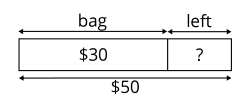
\($50 - $30 = $20\)
She had \($20\) left.
Answer:
\($20\)
Question 2:
Mr Tan bought a television set for \($699\). He gave the cashier \($1000\). How much change should he receive?
Solution:
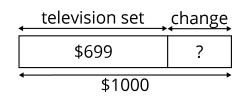
\($1000 - $699 = $301\)
He should receive \($301\) change.
Answer:
\($301\)
Question 3:
Victor bought \(2\) watches that cost \($101.95\) each. He paid the cashier \($250\). How much change should he receive?
Solution:

Cost of 2 watches\(\begin{align}\\ &= $101.95 + $101.95 \\ &= $203.90 \end{align}\)
Change\(\begin{align}\\ &= $250.00 - $203.90\\ &= $46.10 \end{align}\)
He should receive \($46.10\) change.
Answer:
\($46.10\)
Question 4:
Zoe bought a pair of shoes for \($95.80\) and a pair of socks for \($4.90\). She paid the cashier \($110\). How much change should she receive?
Solution:

Total cost of the shoes and the socks\(\begin{align}\\ &= $95.80 + $4.90\\ &= $100.70 \end{align}\)
Change\(\begin{align}\\ &= $110.00 - $100.70\\ &= $9.30 \end{align}\)
She should receive \($9.30\) change.
Answer:
\($9.30\)
Question 5:
Jeremy had \($300\). He paid \($250\) for his son’s tuition fees and \($28.50\) for material fees. How much money did he have left?
Solution:

Amount of money spent\(\begin{align}\\ &= $250.00 + $28.50\\ &= $278.50 \end{align}\)
Amount of money left\(\begin{align}\\ &= $300.00 - $278.50\\ &= $21.50 \end{align}\)
He had \($21.50\) left.
Answer:
\($21.50\)
3. Finding the cost of an item
Question 1:
Melissa bought a bag. She gave the cashier \($100\) and received a \($40\) change. How much did the bag cost?
Solution:

\($100 - $40 = $60\)
The bag cost \($60\).
Answer:
\($60\)
Question 2:
Tom bought a T-shirt at a shop. He paid the cashier \($40\) and received a change of \($16.25\). How much did the T-shirt cost?
Solution:
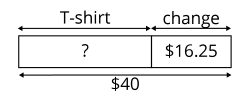
\($40.00 - $16.25 = $23.75\)
The T-shirt cost \($23.75\).
Answer:
\($23.75\)
Question 3:
Mark bought a notebook at a shop. He paid the cashier \($50\) and received a change of \($18.45\). How much did the notebook cost?
Solution:

\($50.00 - $18.45 = $31.55\)
The notebook cost \($31.55\).
Answer:
\($31.55\)
Question 4:
Mrs Chan went to Ubi supermarket and bought some items. She paid the cashier \($50\) and received a change of \($34.35\). However, she accidentally tore the receipt as shown. How much did the grapes cost?
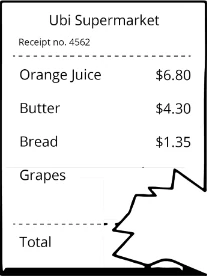
Solution:
Amount of money spent\(\begin{align}\\ &= $50 - $34.35\\ &= $15.65 \end{align} \)
The total cost of orange juice, butter and bread\(\begin{align}\\ &= $6.80 + $4.30 + $1.35\\ &= $12.45 \end{align}\)
Cost of the grapes\(\begin{align}\\ &= $15.65 - $12.45\\ &= $3.20 \end{align}\)
The grapes cost \($3.20\).
Answer:
\($3.20\)
Question 5:
Kim went shopping and bought some items. She paid the cashier \($100\) and received a change of \($13.50\). She accidentally tore the receipt as shown. How much did the dress cost?

Solution:
Amount spent\(\begin{align}\\ &= $100 - $13.50\\ &= $86.50 \end{align}\)
The total cost of the necklace and the shoes\(\begin{align}\\ &= $12.80 + $34.20\\ &= $47.00 \end{align}\)
Cost of the dress\(\begin{align}\\ &= $86.50 - $47.00\\ &= $39.50 \end{align}\)
The dress cost \($39.50\).
Answer:
\($39.50\)


 SG
SG  VN
VN 

